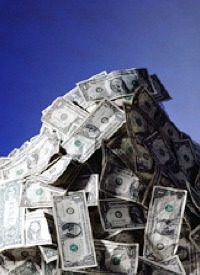
If there were any lingering doubts as to where the Federal Reserve’s expansive monetary policies are leading, they were dispelled by yesterday’s shocking announcement that the Fed intends to purchase more than $1 trillion in additional debt, which it will pay for by printing new money.
In addition to $100 billion in new agency debt, the Federal Open Market Committee intends to buy up $750 billion additional debt in mortgage-backed securities and $300 billion in long-term U.S. Treasury securities. This last is especially alarming, since the direct purchase of long-term Treasuries — an activity the Fed has not engaged in for decades — is highly inflationary, even in contrast to the usual purchase and sales of short-term debt instruments that normally comprise the bulk of the Fed’s open market operations. In effect what the Fed will be doing is creating more than a trillion dollars in new money — this on top of the trillions already created in response to the economic meltdown.
This means inevitably that the dollar stands to lose an enormous amount of purchasing power as the trillions in new money drive up prices in a coming inflationary episode that will make any such that America has seen since at least the Civil War pale into insignificance.
Interestingly, the Powers that Be understand very well what the consequences of the Fed’s actions are likely to be. Said the New York Times:
Having already reduced the key interest rate it controls nearly to zero, the central bank has increasingly turned to alternatives like buying securities as a way of getting more dollars into the economy, a tactic that amounts to creating vast new sums of money out of thin air…. But there were also clear indications that the Fed was taking risks that could dilute the value of the dollar and set the stage for future inflation. [After the Fed’s latest announcement] gold prices rose $26.60 an ounce, hitting $942, a sign of declining confidence in the dollar. The dollar, which had been losing value in recent weeks to the euro and the yen, dropped sharply again on Wednesday….
Jan Hatzius, chief economist at Goldman Sachs, said the Fed had adopted a “kitchen sink” strategy of throwing everything it had to jolt the economy out of its downward spiral.
But while Mr. Hatzius applauded the decision, he cautioned that the central bank could not solve the economy’s problems by expanding cheap money.
“Even if the Fed could make interest rates negative, that wouldn’t necessarily help,” Mr. Hatzius said. “We’re in a deep recession mainly because the private sector, for a variety of reasons, has decided to save a lot more. You can have a zero interest rate, but if you just offer more money on top of the money that is already available, it doesn’t do that much.”
Fed officials have been wrestling for months with the fact that lenders remain unwilling to lend and borrowers are unwilling or unable to borrow. Even though the Fed has been creating money at the fastest rate in its history, much of that money has remained dormant.
This is precisely what happened during the early years of the Great Depression. Then, as now, the Fed tried to pump more money into the economy via debt, but found few takers. This time around, the new money may, in the Times’ words, “remain dormant” for a while, but eventually, it will find its way into the circulating money supply, destroying the value of the dollar both at home and abroad and quite possibly creating hyperinflation that will wipe out personal savings and send consumer prices skyrocketing by hundreds or thousands of percent.
In post-World War I Germany, the German government, hard-pressed to come up with the enormous sums required to pay wartime debts and also punitive reparations imposed by the victorious Allies, resorted to the printing presses in a desperate bid to keep the country solvent. The result was the most extreme instance of hyperinflation in history that beggared Germany and laid the groundwork for the rise of the Nazi dictatorship.
Like Germany of nine decades ago, America finds itself in an intractable recession accompanied by crippling levels of national debt occasioned by decades of irresponsible deficit spending. And the only solution that the Powers that Be can conjure up is — more debts and deficits, accompanied by the inevitable monetization that will ruin the value of our currency.
As for Hatzius’ indictment of the private sector and its newfound frugality, he is correct, although not in the way that he and others of a Keynesian bent intend. The recession is being created by consumers’ refusal to spend and take on more debt. But that is the cure, not the cause, of our economic maladies. The conditions that triggered this mother of all recessions — the unprecedented asset bubble — were solely the fault of the government, particularly the Federal Reserve and other central banks. But instead of abolishing the offending entities, we continue to permit the Fed and its accomplices at the U.S. Treasury department to make things worse and worse.
The stark reality is that, as with Germany in the 1920s, we will never be able to pay our colossal debts in full. At some juncture, after the Fed and the government have run up trillions more in feckless debt, this realization will dawn upon the rest of the world. At that point the United States, reduced to international pauperdom, will be forced, like Germany, to beg China and other international holders of large amounts of U.S. debt to offer some kind of settlement terms that will involve wiping unpayable debts off the books. When that event occurs, the sterling credit that the United States has always enjoyed will vanish, with economic consequences that scarcely bear imagining.



